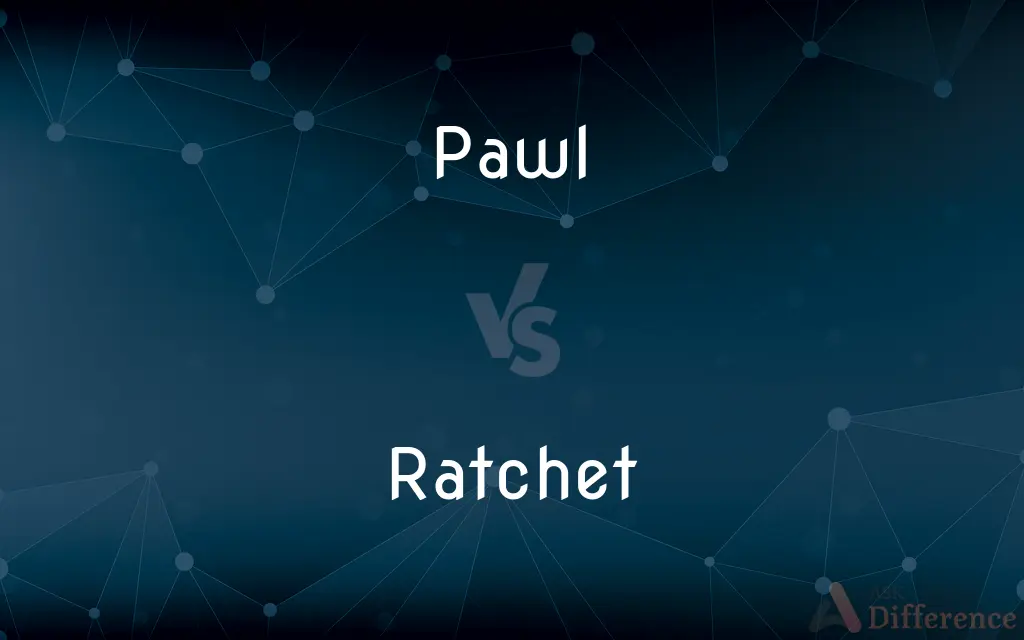Pawl vs. Ratchet — What's the Difference?
Edited by Tayyaba Rehman — By Urooj Arif — Updated on April 8, 2024
A pawl engages with a ratchet to prevent backward motion, while a ratchet is a gear or wheel that allows movement in one direction only.

Difference Between Pawl and Ratchet
Table of Contents
ADVERTISEMENT
Key Differences
A pawl is a mechanical component designed to engage with the teeth of a ratchet wheel or gear, allowing rotation or movement in one direction while preventing it in the opposite direction. On the other hand, a ratchet refers to the toothed wheel or gear itself, which works in conjunction with a pawl to achieve this unidirectional movement. The pawl mechanism is crucial for the ratchet to function as intended, ensuring that devices or machinery incorporating these components can operate securely and efficiently.
The primary function of a pawl is to lock the motion of the ratchet wheel by fitting into the spaces between its teeth, preventing reverse movement. In contrast, the ratchet is designed to facilitate motion in a desired direction, often incorporating a series of teeth with a specific shape that allows the pawl to slip over them in one direction and lock into place against reverse motion. This interaction between the pawl and ratchet is fundamental in tools, machinery, and devices requiring controlled movement.
Pawls are typically small, pivoted catches or levers that are spring-loaded to ensure they consistently engage with the ratchet's teeth. Meanwhile, ratchets are usually circular or cylindrical gears or wheels that can vary significantly in size, shape, and complexity depending on their application. The design and material of both pawls and ratchets are tailored to their specific use, highlighting the importance of each component's role in the overall mechanism.
Applications of pawl and ratchet mechanisms are widespread, ranging from simple hand tools like wrenches and jacks to complex machinery such as clocks, hoists, and various types of locking mechanisms. While the pawl is integral in controlling the direction of movement, the ratchet's design determines the efficiency and smoothness of the forward motion, underscoring their interdependent functionality.
The distinction between a pawl and a ratchet lies in their roles within mechanical systems: the pawl acts as a controlling or locking device, while the ratchet provides the pathway for controlled movement. This complementary relationship allows for the precise control of motion, which is essential in a wide array of mechanical applications and devices.
ADVERTISEMENT
Comparison Chart
Definition
A mechanical component that locks motion in one direction
A gear or wheel allowing movement in one direction only
Function
Engages with ratchet teeth to prevent backward motion
Facilitates forward motion and interacts with the pawl
Design
Small, pivoted catch or lever, often spring-loaded
Toothed wheel or gear with a specific shape for direction
Material
Depends on application, often metal for durability
Varies, tailored to the specific use and load requirements
Application
Used in conjunction with a ratchet in tools and machinery
Essential in devices requiring controlled unidirectional movement
Compare with Definitions
Pawl
Pawls are typically small, pivoted components integral to the functionality of ratchets.
The small, pivoted pawl was crucial for the tool's precision.
Ratchet
A ratchet is a gear or wheel that allows motion in only one direction.
The ratchet wheel turned smoothly, allowing the chain to move in only one direction.
Pawl
A pawl functions as a locking mechanism, preventing backward or reverse motion.
The pawl clicked into place, securing the winch and preventing it from unwinding.
Ratchet
Its teeth are specially designed to work with a pawl, facilitating controlled movement.
The unique design of the ratchet's teeth made it highly efficient and reliable.
Pawl
It is often designed to be spring-loaded to ensure consistent engagement with the ratchet.
The spring-loaded pawl ensured that the device maintained tension.
Ratchet
They can vary significantly in size and complexity, tailored to their specific use.
The large ratchet was designed for industrial applications, capable of handling significant loads.
Pawl
They are used in a wide variety of applications, from simple hand tools to complex machinery.
The engineer inspected the pawl for wear and tear, given its critical role in the machine's operation.
Ratchet
Ratchets are central to many mechanical systems requiring controlled directional movement.
The ratchet mechanism allowed the hoist to lift heavy loads without slipping.
Pawl
Made from durable materials, pawls are built to withstand repetitive use.
The metal pawl was designed to endure thousands of cycles without failure.
Ratchet
Found in various tools and machinery, ratchets are versatile in application.
From simple wrenches to complex automotive systems, ratchets are ubiquitous in engineering.
Pawl
A pawl is a mechanical component that engages with another component to prevent movement in one direction, or prevent movement altogether. It is a type of latch.
Ratchet
A mechanism consisting of a pawl that engages the sloping teeth of a wheel or bar, permitting motion in one direction only.
Pawl
A hinged or pivoted device adapted to fit into a notch of a ratchet wheel to impart forward motion or prevent backward motion.
Ratchet
The pawl, wheel, or bar of this mechanism.
Pawl
A pivoted catch designed to fall into a notch on a ratchet wheel so as to allow movement in only one direction (e.g. on a windlass or in a clock mechanism), or alternatively to move the wheel in one direction.
Ratchet
A dance featuring ratcheting movements of the arms bent at the elbows.
Pawl
A similar device to prevent motion in other mechanisms besides ratchets.
Ratchet
To cause to increase or decrease by increments:tried to ratchet up interest in the program.
Pawl
(transitive) To stop with a pawl.
Ratchet
To increase or decrease by increments.
Pawl
A pivoted tongue, or sliding bolt, on one part of a machine, adapted to fall into notches, or interdental spaces, on another part, as a ratchet wheel, in such a manner as to permit motion in one direction and prevent it in the reverse, as in a windlass; a catch, click, or detent. See Illust. of Ratchet Wheel.
Ratchet
Lacking in class, refinement, or good taste.
Pawl
To stop with a pawl; to drop the pawls off.
Ratchet
A pawl, click, or detent for holding or propelling a ratchet wheel, or ratch, etc.
Pawl
A hinged catch that fits into a notch of a ratchet to move a wheel forward or prevent it from moving backward
Ratchet
A mechanism composed of a ratchet wheel, or ratch and pawl.
Ratchet
A ratchet wrench.
Ratchet
(by extension) A procedure or regulation that goes in one direction, usually up.
Ratchet
A noisemaker or musical instrument where sound is generated by a board striking against a rotating gear. See gragger, raganella.
Ratchet
(transitive) To cause to become incremented or decremented.
It's time to ratchet up the intensity level here.
Ratchet
(intransitive) To increment or decrement.
Ratchet
Ghetto; unseemly, indecorous.
Ratchet
A pawl, click, or detent, for holding or propelling a ratchet wheel, or ratch, etc.
Ratchet
A mechanism composed of a ratchet wheel, or ratch, and pawl. See Ratchet wheel, below, and 2d Ratch.
Ratchet
Mechanical device consisting of a toothed wheel or rack engaged with a pawl that permits it to move in only one direction
Ratchet
Move by degrees in one direction only;
A ratcheting lopping tool
Common Curiosities
Can a ratchet work without a pawl?
A ratchet requires a pawl to function correctly, as the pawl is necessary to prevent reverse movement.
How do pawls and ratchets contribute to machinery safety?
They contribute to safety by allowing precise control over movement, preventing unintended reverse motion that could cause accidents or damage.
Can the design of a ratchet's teeth vary?
Yes, the design of a ratchet's teeth can vary to suit different applications, optimizing the mechanism for efficiency and reliability in various contexts.
Is the pawl always directly in contact with the ratchet?
In most mechanisms, the pawl is in direct contact with the ratchet's teeth to control the direction and movement effectively.
Are pawls and ratchets made from specific materials?
Yes, pawls and ratchets are often made from metals such as steel for durability and longevity, although the specific material can vary based on the application.
What are some common applications of pawl and ratchet mechanisms?
Common applications include hand tools like wrenches, mechanical hoists, clocks, and various safety and locking devices.
Do all mechanical systems with a ratchet and pawl operate manually?
While many systems are manual, there are also automated or motor-driven systems that utilize ratchet and pawl mechanisms for controlled movement.
What factors influence the design of a ratchet wheel?
Factors include the intended direction of movement, load capacity, environmental conditions, and the specific application's requirements.
How do environmental conditions affect pawl and ratchet mechanisms?
Extreme temperatures, dust, and moisture can affect performance, necessitating designs that can withstand such conditions or regular maintenance.
What is the primary role of a pawl in a ratchet mechanism?
The primary role of a pawl is to engage with the teeth of a ratchet, allowing movement in one direction while preventing it in the opposite direction.
How does a pawl move over the ratchet's teeth in the allowed direction?
The pawl typically has a spring mechanism that allows it to slide or pivot over the teeth in the allowed direction while locking into place against reverse movement.
Are there different types of pawls?
Yes, there are different types of pawls designed for specific functions and mechanisms, such as silent pawls or multi-tooth pawls for increased load capacity.
Is there a limit to the size of objects that ratchet and pawl mechanisms can handle?
While there are practical limits based on current materials and designs, innovations continue to extend the size and load capacities of these mechanisms.
How is wear and tear managed in ratchet and pawl mechanisms?
Regular maintenance, lubrication, and using materials suited to the operational stress help manage wear and tear, extending the lifespan of the components.
Can the efficiency of a ratchet mechanism be improved?
Yes, by optimizing the design of the teeth and the pawl, and ensuring precise manufacturing, the efficiency of a ratchet mechanism can be significantly improved.
Share Your Discovery

Previous Comparison
Affix vs. Suffix
Next Comparison
Actual vs. PotentialAuthor Spotlight
Written by
Urooj ArifUrooj is a skilled content writer at Ask Difference, known for her exceptional ability to simplify complex topics into engaging and informative content. With a passion for research and a flair for clear, concise writing, she consistently delivers articles that resonate with our diverse audience.
Edited by
Tayyaba RehmanTayyaba Rehman is a distinguished writer, currently serving as a primary contributor to askdifference.com. As a researcher in semantics and etymology, Tayyaba's passion for the complexity of languages and their distinctions has found a perfect home on the platform. Tayyaba delves into the intricacies of language, distinguishing between commonly confused words and phrases, thereby providing clarity for readers worldwide.
















































